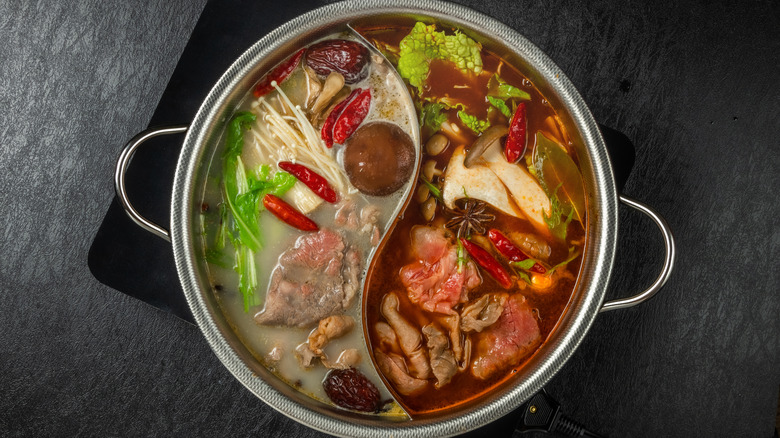The Conflicting Theories Behind Hot Pot's Origins
Have you ever sunk a spoon and a pair of chopsticks into a deep bowl of hotpot? If so, then you know that this widely appreciated Asian dish can be absolutely delicious and fun to eat, too. A communal dining experience much like fondue or Korean BBQ, hotpot consists of a large bowl of hot broth flavored with various elements, which is accompanied by plates and platters of sliced and diced ingredients ranging from raw shellfish to cubes of tofu to sliced mushrooms. As friends and family enjoy the meal together, they can add their favorite items right into the communal bowl of broth, cooking and eating as they go.
Typically associated with Chinese food, hotpot is commonly seasoned with all kinds of traditional Chinese ingredients, from soy sauce to sesame oil to Sichuan peppercorns. But variations of the dish are, today, enjoyed all across Asia, from Japan to Korea. Which begs the question: Where, exactly, did hotpot originate?
Hotpot's country of origin is debated
Immensely common in the Chinese region of Sichuan and the city of Beijing, hotpot is typically regarded as Chinese. Its name in Chinese, huǒguō, means "fire pot," and some origin stories trace its beginnings to boatmen paddling the Yangtze and Jialing rivers around Chongqing, China, partaking in an inexpensive and efficient way to eat. Other theories, however, link early hotpots to roving Mongol warriors. As they traveled and camped across Asia and beyond, they'd circle around their fires to enjoy a communal broth or stew, perhaps even cooking the hotpot in one of their overturned helmets.
Wherever hotpot came from, it's definitely been around for a long time. The Chinese poet Zuo Si that lived from 250 to 305, mentioned Sichuan hotpot in his poem "Rhapsody of the Three Capitals" — and folks around the world still love to sit down around this often-spicy dish, dunk some meat and veggies, and while away the time around a delicious meal.

